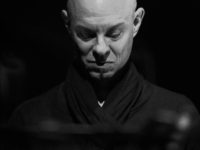Nik Bärtsch calls a concert a “meditative and explosive form of collaboration,” but exactly the same can be said about his and his band Ronin’s self-described “ritual groove music.” That’s why when I first learned that Ronin was releasing a double-disc live album, simply called Live, I figured to hear a tight unit able to deliver its carefully modulated, rhythmically layered ostinatos with all the aplomb and perhaps a tad more energy than the already tightly-woven, kinetic studio affairs.
And, as it turned out, I was right.
Nik Bärtsch’s Ronin was first formed in 2001 and made several records under their own label before joining ECM for their 2006 album, Stoa, and the lineup stabilized around that time with Bärtsch, Björn Meyer (electric bass), Kaspar Rast (drums) and Sha (bass clarinet, alto sax). Live covers select recordings of live performances made 2009-2011 over Europe and Japan. It should be noted that this isn’t their first live album; the identically titled original Live (2003) was self-released early in the band’s history. The one that’s the subject of this article has the ECM lineup and was produced spotlessly by label founder Manfred Eicher, who not only got the mix bang on, but also rinsed out nearly all the crowd noise while retaining the stage shouts and grunts that sometimes signals a climatic moment.
The material is all originals from their prior records. Ronin is not really built to play other people’s songs, but like the perfect integration between software and hardware by the same creators, the songs and the performances of those songs are one and the same. The approach is to raise groove-based vamps, riffs and repeating figures in a high art form.
“Modul 35,” for instance, is a single chord song. Boring, right? Not in the least. There’s more drama and intrigue packed in this song than a Bond movie (and could probably make a credible instant soundtrack to a Mission Impossible flick.) “Modul 41_17” oscillates between two bass notes, held down by Bärtsch’s piano so Meyer can step out and stretch out some for a while. But the harmony of the song evolves, keeping it moving along and hold listeners in anticipation of what’s going to happen next. “Modul 22,” which begins with some thumb popping bass soloing wandering into the high registers, plays the same riff but switches the key up and down when suddenly, it explodes into a louder, more resonant riff. Very gradually, with symphony-like precision, the intensity falls away and the song literally disappears into the ether. The layering of complementing repeating figures is another favored device of Ronin, and they do it particularly well on “Modul 45.”
In 2011, Meyer was replaced at bass by Thomy Jordi, who makes his Ronin debut on record on the very last track “Modul 55.” That also happens to be the track where the bass has its lightest workload, so it’s too difficult to use that performance for a comparison between Meyer and Jordi. Chances are very great that Bärtsch hired a very capable bassist in Jordi, since that role is so important to the sound of the band.
Thus, the recordings heard on Live are a lot like what you hear on the studio albums, breathtakingly replicated on the stage without a safety net, and the lack of the security only appeared to encouraged them to take even more chances. Hearing this while knowing that makes listening an even bigger thrill. Honestly, Ronin should do all their records live, and as much as I’ve enjoyed Bärtsch’s studio releases, Live is all the Ronin most anyone needs (until the next live album comes along). But you do need it; you won’t get a groove like this from anywhere else.
Live went on sale on October 2, by ECM Records. Go to the official Nik Bärtsch’s Ronin website for more info.
Click on image to purchase …






